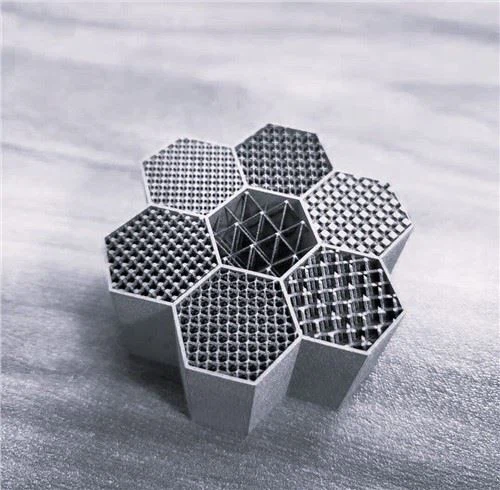How does selective laser melting work?
Like any other 3D printing process, SLM metal 3D printers need a CAD file as a blueprint for the desired part. The data set is cut into several layers by a slicer. Each layer forms a cross-section through the component. A layer thickness in 3D printing SLM usually varies between 20 and 60 micrometers. In the SLM 3D printing process, a squeegee spreads a layer of metal powder onto a lower-able-build platform. A laser then scans the cross-section of the part and melts the powder in those areas. Because the powder cannot be compressed as densely as in SLS, the process relies on printed support structures in most cases. They serve to keep the components stable in the build space, dissipate excess heat, and prevent the deformation of the parts.
How did SLM 3D technology come about?
Compared to the SLA, FDM, or SLS processes, which were all patented towards the end of the 1980s, selective laser melting emerged somewhat later. The first notable successes were announced in 1995 by the Fraunhofer Institute for Laser Technology in Aachen. In cooperation with the company F&S Stereolithografietechnik GmbH, the SLM 3D printing process was developed. The company split in the early 2000s into Realizer GmbH, which today belongs to DMG Mori AG, and SLM Solutions AG, which is still one of the leading suppliers of SLM metal 3D printing.
What are the advantages of selective laser melting?
Like the vast majority of 3D printing technologies, selective laser melting also brings with it a great deal of geometric freedom. This means that highly complex geometries and bionic lightweight construction projects can be implemented without tools. Assembly consolidation is another advantage of SLM and also other 3D printing technologies. This involves bringing together individual assemblies and printing them directly in one piece to reduce material labor and assembly costs. But it’s not just the geometric freedom of the technology that makes exciting components possible. The component properties themselves can also be improved by the SLM process. For example, the components are characterized by a particularly high density and almost pore-free surfaces.
What materials are used in selective laser melting?
Selective laser melting is used to process metals. The development of new materials is a continuously advancing field of research, and new suppliers or established companies are constantly entering the market with a greater variety of materials. The most established materials for SLM 3D printing include aluminum (AlSi10Mg), tool and stainless steel (316L), and titanium (TC4).
What can selective laser melting be used for?
Many industries benefit from selective laser melting as an additive manufacturing technology. These include aerospace, automotive engineering, dental and medical technology, and mechanical engineering. The technology is used in particular for rapid prototyping, but small series can now also be economically produced using SLM metal 3D printing.
How does selective laser melting compare to Binder Jetting technology?
Selective laser melting differs from Binder Jetting mainly in build volume, material diversity, and applications. The most significant difference between Binder Jetting and SLM is materials.
Binder Jetting technology is compatible with sand, ceramic, and plastic whereas SLM utilizes metallic powder materials to print metal products. SLM prints parts directly into metal whereas Binder Jetting technology requires a sand mold to be cast in metal. Binder Jetting is typically used across a wide array of industries such as automotive, aerospace, industrial, and more. SLM is utilized by industries including dental, medical technology, mechanical engineering, aerospace, and automotive engineering. Binder Jetting has a highly streamlined printing process that can easily accommodate large-scale production whereas SLM is mainly used for prototyping and more recently small series production. For smaller-scale production and singular end-use metal parts and prototyping, SLM can be utilized. For large-scale meta
3D Printing Service Option
When the metal powder is completely melted under high-energy laser powder, for example, a phase transition from the solid to the liquid aggregate state occurs, we are talking about selective laser melting (SLM technology). SLM process is used particularly in the processing of metals to compete with metal casting technology in a small segment.
From tested data on common metal materials in this application, if we have the right parameters we could see better data performance on density and mechanical strength over casting and close to forging.
| SLM | SLS | FDM | SLA | DLP |
| Aluminum
Stainless Steel CoCr Titanium |
Nylon
Fiber Carbon Fiber |
PLA
ABS TPU PETG |
Resin | Liquid Resin |
 |
 |
 |
 |
 |



